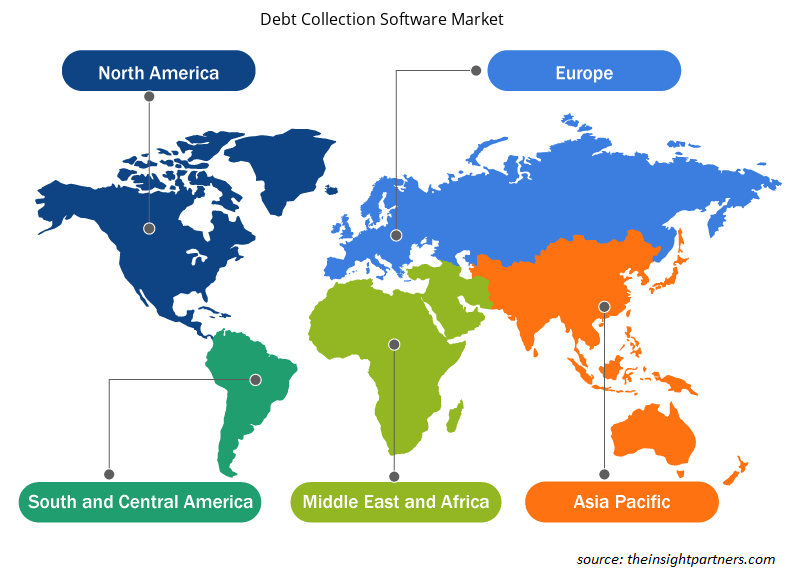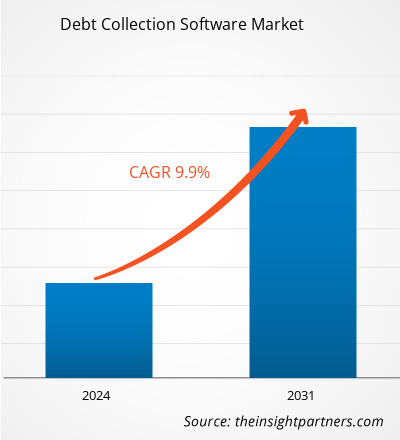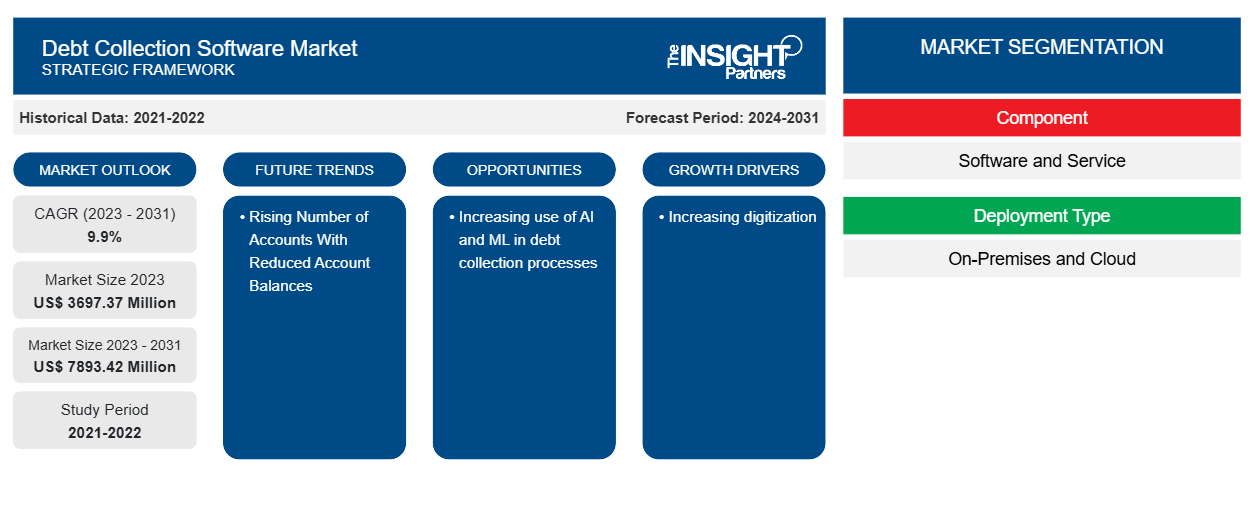من المتوقع أن يصل حجم سوق برامج تحصيل الديون إلى 7893.42 مليون دولار أمريكي بحلول عام 2031 من 3697.37 مليون دولار أمريكي في عام 2023. ومن المتوقع أن يسجل السوق معدل نمو سنوي مركب بنسبة 9.9٪ خلال الفترة 2023-2031. ومن المرجح أن يظل العدد المتزايد من الحسابات ذات الأرصدة المنخفضة يمثل اتجاهًا رئيسيًا في السوق.
تحليل سوق برامج تحصيل الديون
يقدم برنامج تحصيل الديون فوائد مختلفة. فهو يجمع كل ملفات تعريف المدينين في مكان واحد، بما في ذلك عنوانهم ومعلومات بطاقة الائتمان والرصيد الحالي وتقرير شامل عن المدفوعات المتأخرة للدين، مثل المبلغ وعمر الدين وما إلى ذلك. ومن الضروري تبادل المعلومات بين الدائنين وDCA فيما يتعلق بملف تعريف المدين وموقعه ومعلومات الاتصال والمعلومات الإضافية المتعلقة بديونه وما إلى ذلك. ويُعَد الاستعانة بمصادر خارجية (BPO) اسمًا آخر لهذه العملية الخاصة بمشاركة البيانات. ويمكن استخدام البرامج وواجهات برمجة التطبيقات لتحصيل الديون لجمع الرسوم من كل من الشركات والمستهلكين. وبالتالي، مع هذه الفوائد، ينمو سوق برامج تحصيل الديون.
نظرة عامة على سوق برامج تحصيل الديون
يتم استخدام برامج تحصيل الديون لأتمتة العمليات المختلفة المشاركة في تحصيل الديون. تعمل أتمتة عملية الأعمال هذه على تبسيط العديد من مكونات عملية تحصيل الديون وإزالة الاحتكاك لتمكين جهود تحصيل أكثر فعالية وكفاءة. يؤدي الاتصال والتفاعل في قناتهم في الوقت المناسب إلى تحسين كيفية إدراك العملاء للأعمال وتحديد احتمالية تحقيق نتيجة ناجحة. من خلال إضافة جميع العناصر التي توفر محادثات فعالة وفعّالة مثل القنوات الرقمية. ستعمل الأتمتة والمشاركة المختلطة وواجهات برمجة التطبيقات والذكاء الاصطناعي على تحويل كيفية تفاعل العملاء وتوليد المزيد من المدفوعات بشكل أسرع.
قم بتخصيص هذا التقرير ليناسب متطلباتك
ستحصل على تخصيص لأي تقرير - مجانًا - بما في ذلك أجزاء من هذا التقرير، أو تحليل على مستوى الدولة، وحزمة بيانات Excel، بالإضافة إلى الاستفادة من العروض والخصومات الرائعة للشركات الناشئة والجامعات
- احصل على أهم اتجاهات السوق الرئيسية لهذا التقرير.ستتضمن هذه العينة المجانية تحليلاً للبيانات، بدءًا من اتجاهات السوق وحتى التقديرات والتوقعات.
محركات وفرص سوق برامج تحصيل الديون
زيادة الرقمنة
لقد أدى جائحة كوفيد-19 إلى تسريع إدخال المعاملات غير النقدية. إن الخدمات المصرفية الرقمية هي القاعدة، وبما أن تحصيل الديون ينطوي على معاملات مالية، فمن الواضح أن الرقمنة مسؤولة عن البنوك ووكالات تحصيل الديون. ومع زيادة حالات التخلف عن السداد، تستخدم مؤسسات الإقراض في جميع أنحاء العالم بشكل متزايد تقنيات تحصيل الديون الرقمية لتعزيز معدلات تحصيلها بطريقة فعالة من حيث التكلفة. لذلك، فإن الرقمنة المتزايدة تدفع سوق برامج تحصيل الديون.
زيادة استخدام الذكاء الاصطناعي والتعلم الآلي في عمليات تحصيل الديون
باستخدام الذكاء الاصطناعي والتعلم الآلي، تستخدم منصات تحصيل الديون الرقمية استراتيجيات مختلفة لزيادة الكفاءة. يحصل القليل منها على بيانات بالغة الأهمية من مصادر وقنوات متعددة. يمكن أن تتضمن هذه البيانات معلومات مثل ملف تعريف المقترضين ودخلهم وخياراتهم وتاريخهم الائتماني والمالي وسجلات السداد لإنشاء شرائح صغيرة ذكية، مما يعزز كفاءة استراتيجيات التحصيل التقليدية التي يستخدمها المقرض. وبالتالي، فإن زيادة استخدام الذكاء الاصطناعي والتعلم الآلي في عمليات تحصيل الديون يزيد من الفرص المتاحة للسوق.
تقرير تحليل تجزئة سوق برامج تحصيل الديون
إن القطاعات الرئيسية التي ساهمت في استخلاص تحليل سوق برامج تحصيل الديون هي المكون ونوع النشر وحجم المنظمة والقطاع الرأسي.
- بناءً على المكون، ينقسم سوق برامج تحصيل الديون إلى برامج وخدمات. احتل القطاع المخصص حصة سوقية أكبر في عام 2023.
- بحسب نوع النشر، يتم تقسيم السوق إلى محلي وسحابي. احتلت شريحة التركيب على السطح حصة سوقية أكبر في عام 2023.
- بحسب حجم المنظمة، يتم تقسيم السوق إلى الشركات الكبيرة والشركات الصغيرة والمتوسطة.SMEs.
- بحسب حجم المنظمة، يتم تقسيم السوق إلى تكنولوجيا المعلومات والاتصالات، والخدمات المصرفية والمالية والتأمين، والتجزئة، والتصنيع، وغيرها.BFSI, retail, manufacturing, and others.
تحليل حصة سوق برامج تحصيل الديون حسب المنطقة الجغرافية
ينقسم النطاق الجغرافي لتقرير سوق برامج تحصيل الديون بشكل أساسي إلى خمس مناطق: أمريكا الشمالية، ومنطقة آسيا والمحيط الهادئ، وأوروبا، والشرق الأوسط وأفريقيا، وأمريكا الجنوبية والوسطى.
تهيمن منطقة آسيا والمحيط الهادئ على سوق برامج تحصيل الديون. ويشهد سوق برامج تحصيل الديون في هذه المنطقة نموًا بسبب عوامل مختلفة، مثل زيادة المبادرات الحكومية لتحسين وضوح إضاءة الأنفاق ووجود صناعة نقل راسخة. dominates the debt collection software market. The debt collection software market in this region is growing due to various factors, such as increasing government initiatives to improve the visibility of tunnel lighting and the presence of a well-established transportation industry.
رؤى إقليمية حول سوق برامج تحصيل الديون
لقد قام المحللون في Insight Partners بشرح الاتجاهات والعوامل الإقليمية المؤثرة على سوق برمجيات تحصيل الديون طوال فترة التوقعات بشكل شامل. يناقش هذا القسم أيضًا قطاعات سوق برمجيات تحصيل الديون والجغرافيا في جميع أنحاء أمريكا الشمالية وأوروبا ومنطقة آسيا والمحيط الهادئ والشرق الأوسط وأفريقيا وأمريكا الجنوبية والوسطى.

- احصل على البيانات الإقليمية المحددة لسوق برامج تحصيل الديون
نطاق تقرير سوق برامج تحصيل الديون
| سمة التقرير | تفاصيل |
|---|---|
| حجم السوق في عام 2023 | 3697.37 مليون دولار أمريكي |
| حجم السوق بحلول عام 2031 | 7893.42 مليون دولار أمريكي |
| معدل النمو السنوي المركب العالمي (2023 - 2031) | 9.9% |
| البيانات التاريخية | 2021-2022 |
| فترة التنبؤ | 2024-2031 |
| القطاعات المغطاة | حسب المكون
|
| المناطق والدول المغطاة | أمريكا الشمالية
|
| قادة السوق وملفات تعريف الشركات الرئيسية |
|
كثافة اللاعبين في سوق برامج تحصيل الديون: فهم تأثيرها على ديناميكيات الأعمال
يشهد سوق برامج تحصيل الديون نموًا سريعًا، مدفوعًا بالطلب المتزايد من جانب المستخدم النهائي بسبب عوامل مثل تفضيلات المستهلكين المتطورة والتقدم التكنولوجي والوعي المتزايد بفوائد المنتج. ومع ارتفاع الطلب، تعمل الشركات على توسيع عروضها والابتكار لتلبية احتياجات المستهلكين والاستفادة من الاتجاهات الناشئة، مما يؤدي إلى زيادة نمو السوق.
تشير كثافة اللاعبين في السوق إلى توزيع الشركات أو المؤسسات العاملة في سوق أو صناعة معينة. وهي تشير إلى عدد المنافسين (اللاعبين في السوق) الموجودين في مساحة سوق معينة نسبة إلى حجمها أو قيمتها السوقية الإجمالية.
الشركات الرئيسية العاملة في سوق برمجيات تحصيل الديون هي:
- شركة تشيتو
- فيكو
- شركة سي اس اس
- شركة إكسبيريان لحلول المعلومات
- إكسوس
- حلول لوكسون
إخلاء المسؤولية : الشركات المذكورة أعلاه ليست مرتبة بأي ترتيب معين.

- احصل على نظرة عامة على أهم اللاعبين الرئيسيين في سوق برمجيات تحصيل الديون
أخبار سوق برامج تحصيل الديون والتطورات الأخيرة
يتم تقييم سوق برامج تحصيل الديون من خلال جمع البيانات النوعية والكمية بعد البحث الأولي والثانوي، والذي يتضمن منشورات الشركات المهمة وبيانات الجمعيات وقواعد البيانات. فيما يلي بعض التطورات في سوق برامج تحصيل الديون:
- استبدل مستشفى زيورخ الجامعي (USZ) حل تحصيل الديون السابق المستند إلى SAP بـ Robo-Inkasso من Tilbago AG. ووفقًا لـ USZ، يساعد هذا في تقليل الجهد اليدوي الإجمالي، وبالتالي التكاليف الإجمالية المتضمنة مع تقديم نطاق أكبر من الخدمات. (المصدر: مستشفى زيورخ الجامعي (USZ)، بيان صحفي، ديسمبر 2022)
- أعلنت شركة تالي، وهي شركة ناشئة في مجال التكنولوجيا المالية معروفة بمساعدة الأشخاص على سداد ديون بطاقات الائتمان بجدية، عن إطلاق برنامج إدارة ديون بطاقات الائتمان الخاص بها. ويوسع هذا العرض المقدم للشركات مهمة تالي لمنح المستهلكين مسارًا أفضل لإدارة الديون. ومن المقرر أن يطلق الشريك الأول لتالي، وهي شركة استهلاكية كبيرة مدرجة في البورصة ولديها أكثر من 50 مليون مستخدم، برنامج تالي لمستخدميها في يوليو 2024. جمعت تالي رأس مال إضافيًا من المستثمرين الحاليين لتطوير عرضها المقدم للشركات، وحتى الآن جمعت أكثر من 200 مليون دولار لبناء وتوسيع نطاق المنصة. (المصدر: تالي، بيان صحفي، أبريل 2022)
تقرير سوق برامج تحصيل الديون والتغطية والنتائج
يوفر تقرير "حجم سوق برامج تحصيل الديون والتوقعات (2021-2031)" تحليلاً مفصلاً للسوق يغطي المجالات التالية:
- حجم سوق برامج تحصيل الديون وتوقعاته على المستويات العالمية والإقليمية والوطنية لجميع قطاعات السوق الرئيسية التي يغطيها النطاق
- اتجاهات سوق برامج تحصيل الديون بالإضافة إلى ديناميكيات السوق مثل المحركات والقيود والفرص الرئيسية
- تحليل مفصل لقوى PEST/Porter الخمس وSWOT
- تحليل سوق برامج تحصيل الديون الذي يغطي اتجاهات السوق الرئيسية والإطار العالمي والإقليمي واللاعبين الرئيسيين واللوائح والتطورات الأخيرة في السوق
- تحليل المشهد الصناعي والمنافسة الذي يغطي تركيز السوق، وتحليل خريطة الحرارة، واللاعبين البارزين، والتطورات الأخيرة في سوق برامج تحصيل الديون
- ملفات تعريف الشركة التفصيلية
- التحليل التاريخي (سنتان)، سنة الأساس، التوقعات (7 سنوات) مع معدل النمو السنوي المركب
- تحليل PEST و SWOT
- حجم السوق والقيمة / الحجم - عالمي، إقليمي، بلد
- الصناعة والمنافسة
- مجموعة بيانات إكسل
التقارير الحديثة
تقارير ذات صلة
شهادات العملاء
سبب الشراء
- اتخاذ قرارات مدروسة
- فهم ديناميكيات السوق
- تحليل المنافسة
- رؤى العملاء
- توقعات السوق
- تخفيف المخاطر
- التخطيط الاستراتيجي
- مبررات الاستثمار
- تحديد الأسواق الناشئة
- تحسين استراتيجيات التسويق
- تعزيز الكفاءة التشغيلية
- مواكبة التوجهات التنظيمية





















 احصل على عينة مجانية ل - سوق برامج تحصيل الديون
احصل على عينة مجانية ل - سوق برامج تحصيل الديون